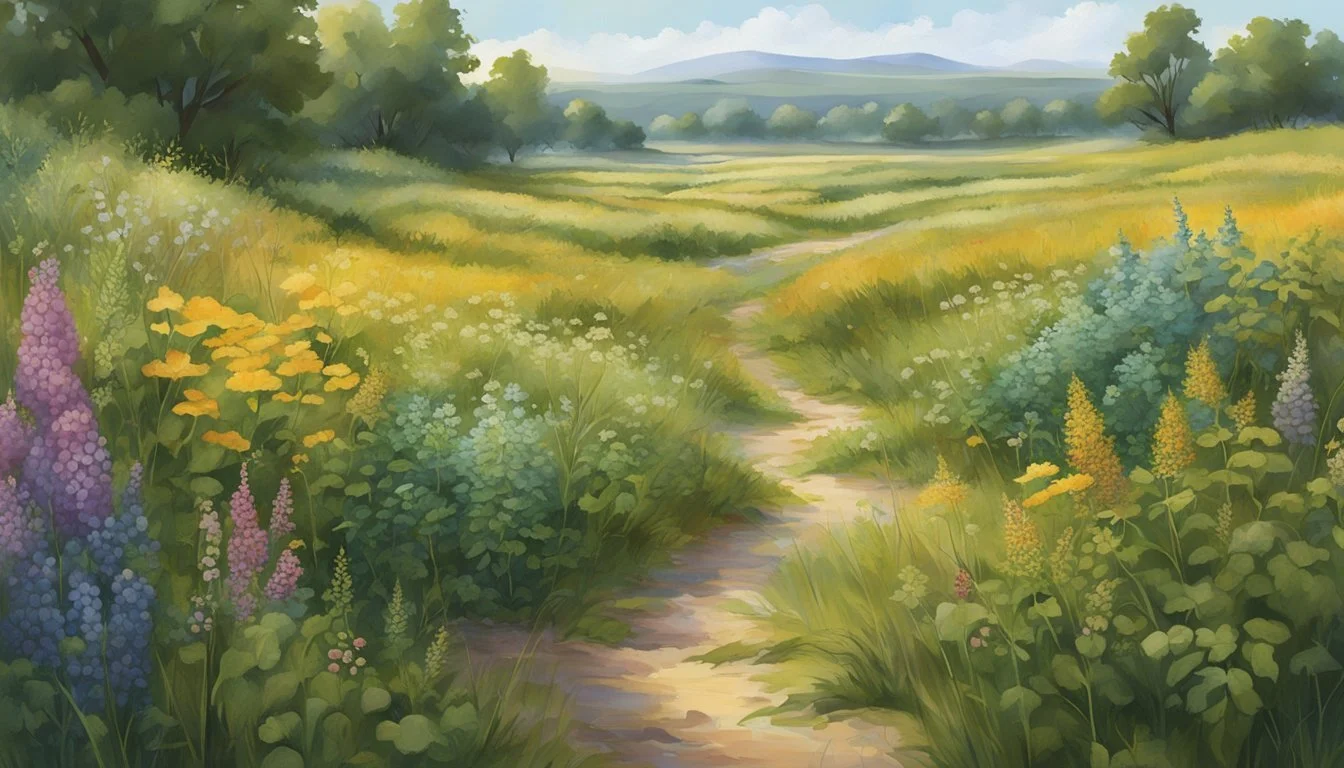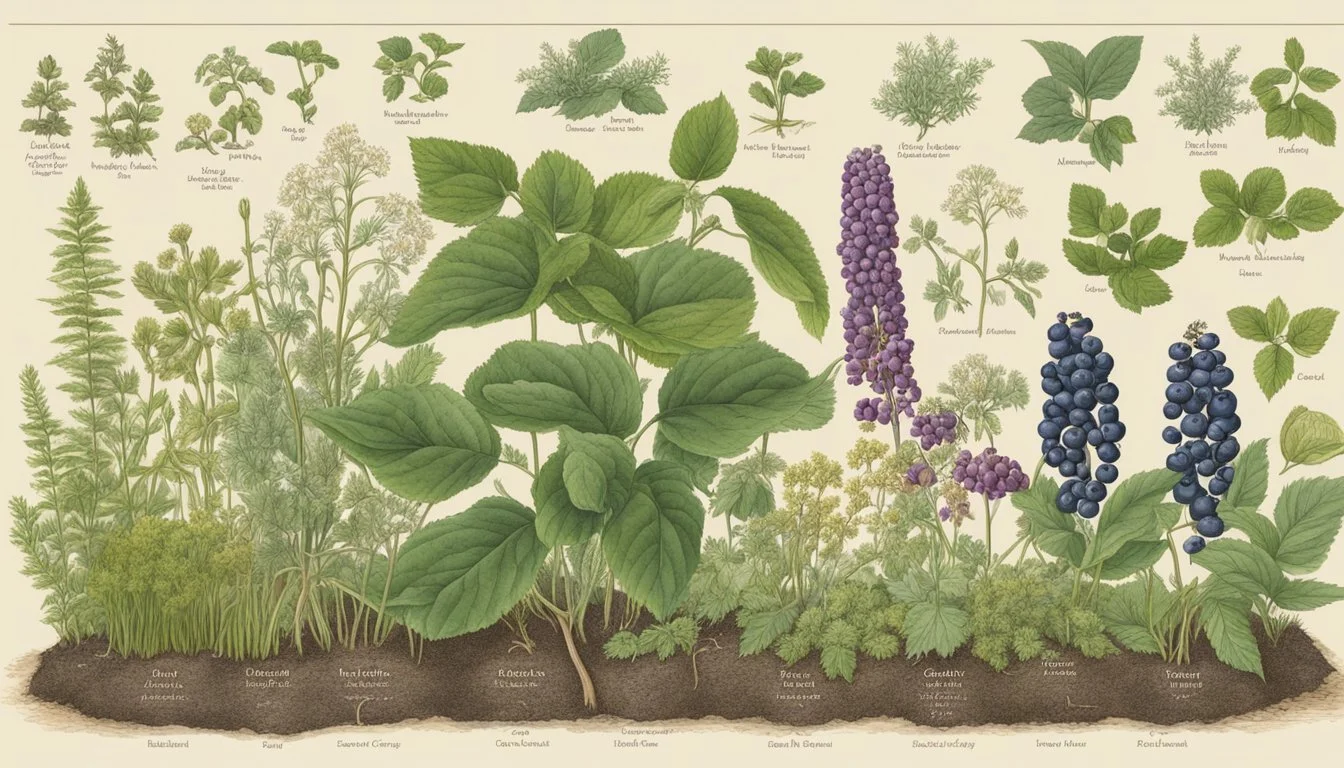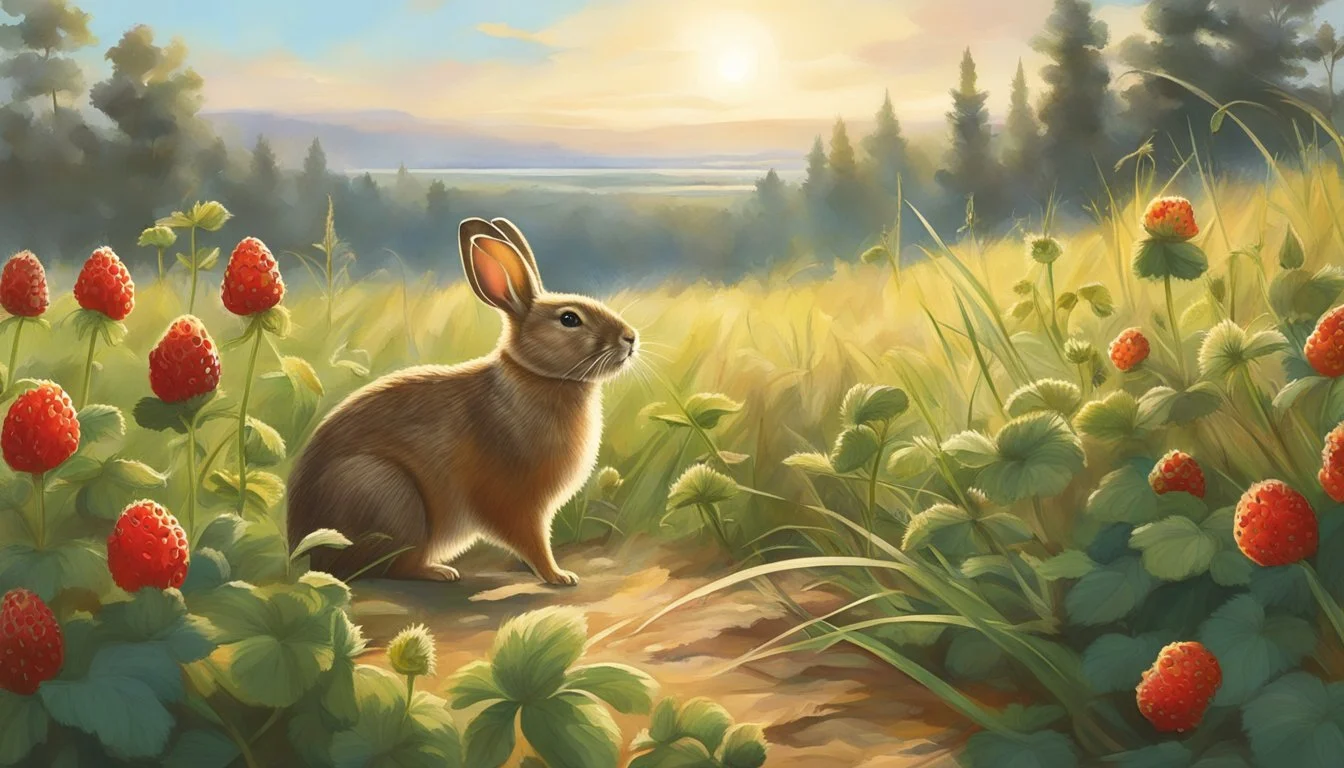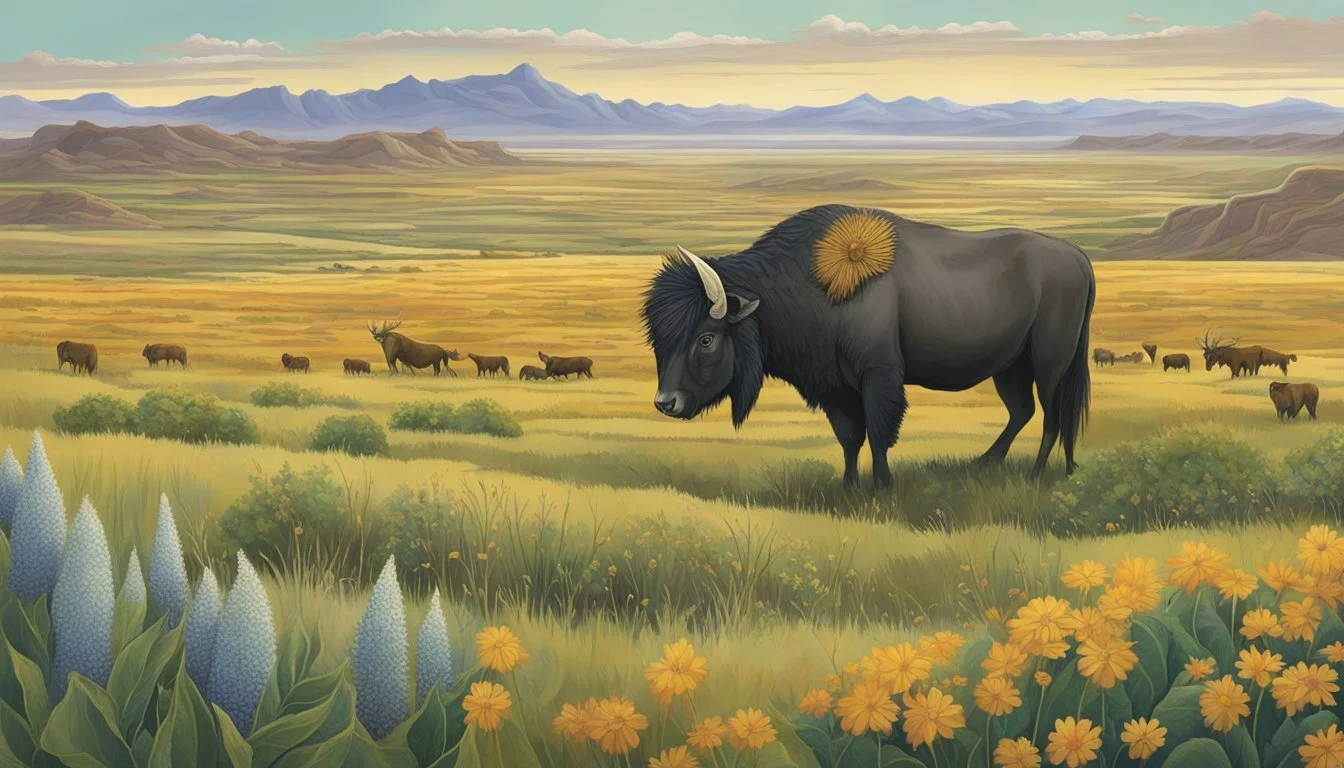High Plains Native Edible Plants
Discovering Wild Culinary Treasures
The High Plains region, with its vast stretches of grasslands and unique ecosystems, hosts an array of native edible plants that were essential to the diets of indigenous peoples. Chokecherry (Prunus virginiana) and prairie turnip (Thíŋpsiŋla or Psoralea esculenta) are two of the most significant native edible plants found across these plains. These plants not only provided sustenance but also played a crucial role in cultural practices and seasonal traditions.
Chokecherry, recognized for its versatility, was a staple for the Plains Indians who harvested the berries to mix with bison meat, creating a nutritious and lasting food source. The prairie turnip, a starchy root, thrived in dry patches and was another key component of their diet, illustrating how the native flora perfectly aligned with the needs of the people who lived there.
For modern foragers and gardeners, understanding these plants offers valuable insights into both historical practices and sustainable food sources. With the right knowledge, anyone can tap into the rich edible offerings of the High Plains, echoing the traditions of the land’s first inhabitants.
Understanding High Plains Flora
High Plains flora includes a wide variety of native plants, each adapted to the region's unique landscapes such as prairies, grasslands, and wetlands. These plants play a critical role in supporting local ecosystems and biodiversity.
Native Plant Heritage
Native plants like chokecherry (Prunus virginiana) and prairie turnip (Psoralea esculenta) have been integral to the diets and cultures of Indigenous peoples for centuries. The Lakota and Dakota tribes, for example, traditionally gathered chokecherries during the Black Cherry Moon, blending the berries with bison meat.
Timpsila, another vital plant, features heavily in their diets due to its nutritional value and availability across the plains.
Diverse Habitats of the High Plains
The High Plains encompass a range of habitats, from expansive prairies and grasslands to wetlands. Each habitat supports distinct flora well-suited to its conditions.
Grasslands host grasses and wildflowers, while wetlands nurture aquatic plants. Prairies sustain species like the Indian potato, and woodlands shelter diverse tree and shrub species. These habitats contribute to the rich biodiversity of the region.
Role of Flora in Local Ecosystems
High Plains flora serves as the backbone of local ecosystems. Plants like beargrass and bitterroot provide food and shelter to insects and small mammals.
Native plants offer nectar and pollen, crucial for pollinators like bees and butterflies. They also stabilize soil, prevent erosion, and support nutrient cycles, thus preserving the ecological balance.
Ecological Importance of Native Edible Plants
Edible native plants not only support human diets but also enhance ecosystem resilience. Chokecherries and pine nuts, with their nutritional benefits, are staples for both wildlife and humans.
These plants contribute to biodiversity by attracting various species, facilitating cross-pollination, and ensuring genetic diversity. Their presence underscores the ecological richness and sustainability of the High Plains.
Each aspect of High Plains flora, from diverse habitats to their role in ecosystems, showcases the region's natural bounty and the crucial part these plants play in maintaining ecological health and supporting human communities.
Identification and Characteristics
Understanding the identification and characteristics of High Plains native edible plants involves examining their visual traits, distinctive features, flowering behaviors, and different plant types like trees, shrubs, and grasses.
Visual Guide to Common Native Edible Plants
Identifying native edible plants starts with their visual traits, such as leaf shape, stem texture, and overall plant structure. For example, the Chokecherry (Prunus virginiana) has distinct serrated leaves and smooth, reddish-brown bark. The Wild Potato (Solanum species) is small, with round leaves and requires careful examination to avoid confusion with its poisonous varieties. Cacti, like the Prickly Pear (Opuntia species), have flat, spiny pads and produce bright yellow flowers. Each plant's unique visual traits aid in their identification and safe consumption.
Distinctive Features of Flora
High Plains native edible plants possess distinctive features that set them apart from non-edible or toxic species. Capsicum annuum, known as the chile pepper, features fleshy fruits with a strong, pungent aroma. Chokecherry berries are typically small, round, and deep red to black in color, often found in clusters. Soloman's-seal has arching stems with small, bell-shaped flowers, and edible tubers found underground. These unique characteristics, such as leaf margins (smooth, serrated, or lobed) and stem textures, are crucial for effective identification.
Flowers and Pollination
Flowers of native edible plants in the High Plains play a vital role in their identification and ecological presence. Chokecherry flowers are small, white, and grow in elongated clusters known as racemes. Prickly Pear cacti produce large, vivid yellow flowers that attract a variety of pollinators. The Wild Potato bears insignificant flowers, mainly focusing on its underground tubers for reproduction. Pollination, primarily by bees and other insects, is essential for fruit development and seed dispersal, ensuring the continuation of these native species.
Trees, Shrubs, and Grasses
Different plant types, including trees, shrubs, and grasses, comprise the High Plains' edible flora. Chokecherry represents both a tree and a shrub, adaptable to various environments. Shrubs like Buffalo Berry (Shepherdia argentea) are recognizable by their silver leaves and red berries, which are a traditional food source. Grasses, though less common in discussions about edibility, provide essential information about the ecosystem, like the Wild Rye (Elymus species) useful in soil stabilization and sometimes consumed in survival situations. Each plant type's features help in creating a comprehensive understanding of the region's edible vegetation.
Nutritional and Medicinal Benefits
High Plains native edible plants provide a wealth of nutritional benefits and have been used in traditional medicine for generations. They offer essential vitamins, minerals, and unique medicinal properties that support overall health and wellness.
Edible Parts of Plants
Various parts of native plants are edible and nutritious. Leaves, flowers, roots, and seeds are commonly consumed. For example, wild garlic bulbs are a rich source of flavor and nutrition. Many of these plants can be eaten raw or cooked, contributing to diverse culinary applications. The diverse parts of these plants make them versatile for different dietary needs and culinary practices.
Nutrition Content in Native Plants
Native plants on the High Plains are particularly rich in vitamins such as A, C, and K, and essential minerals including calcium and iron. For instance, wild spinach (also known as lambsquarters) is high in Vitamin C and calcium. Wild berries, such as buffalo berries, provide antioxidants and vital micronutrients. These components support a balanced diet and can help prevent nutritional deficiencies.
Medicinal Properties of Plants
Beyond their nutritional value, many High Plains native plants possess significant medicinal properties. Willow bark, for example, contains salicin, which has pain-relieving qualities similar to aspirin. Echinacea, commonly found in the region, is known for boosting the immune system and reducing inflammation. These plants have been used by local communities to treat various ailments such as headaches, colds, and digestive issues.
Traditional Medicine and Dietary Use
High Plains indigenous peoples have a long history of using native plants in traditional medicine. Yarrow has been used extensively for its anti-inflammatory and hemostatic properties. Additionally, plants such as sage and mint were commonly used in teas to soothe stomach ailments and improve digestion. The traditional knowledge of these plants has been passed down through generations, emphasizing their importance and effectiveness in natural remedies and maintaining health.
These insights into the nutritional and medicinal benefits of High Plains native edible plants underline their profound impact on both everyday diet and traditional health practices.
Culinary Traditions and Uses
The High Plains offer a rich diversity of native plants with significant culinary history. Many of these plants have been used for centuries by Indigenous peoples for their nutritional and medicinal benefits.
Cooking with Native Plants
Cooking with native plants on the High Plains involves a variety of preparation techniques that highlight their unique flavors and nutritional attributes. The prairie turnip, also known as timpsila, is one of the most notable. This starchy tuber can be roasted, boiled, or dried and ground into flour for baking.
Prickly pear cactus, another versatile plant, provides soft pads that can be grilled or boiled. The fruit can be made into juices, jams, and jellies. Wild herbs like wild mint are commonly used to season meats or brewed as herbal teas.
Morels and other wild mushrooms, often gathered during mushroom hunting expeditions, are prized for their rich flavors and can be sautéed or used in soups. Pawpaw, although less common, offers a custard-like fruit that can be eaten fresh or incorporated into desserts.
Traditional Recipes and Preparation
Traditional recipes from the High Plains often reflect a deep sustainable approach, where every part of the plant is utilized. A staple in many Indigenous diets is chokecherry, which can be dried and mixed with bison meat to create pemmican.
Squash, corn, and beans, known as the "Three Sisters," are cultivated together and form the basis for many traditional stews and soups. The cooking process usually involves slow simmering to meld flavors together.
Edible flowers and herbs add seasonal variety. Wild mint can be dried and used in teas or as a flavoring for various dishes. Bitterroot, though more rare, is another traditional plant used for its starchy root in soups and stews, offering a carbohydrate-rich supplement to the diet.
Foraging and Harvesting
Foraging for native edible plants in the High Plains requires careful techniques to ensure sustainable harvesting. Understanding regulations and proper preservation methods is essential for both conservation and safety.
Techniques for Ethical Foraging
Ethical foraging ensures that native plants are harvested sustainably. This involves picking only what is needed and leaving enough for the plant to regenerate.
Foragers should avoid taking more than one-third of any plant colony. This prevents overharvesting and ensures continued growth.
Understanding plant identification is vital to avoid harming non-edible or protected species. Proper techniques like using a knife rather than pulling by hand minimizes root damage, ensuring that plants can continue to thrive.
Preserving and Storing Edible Plants
Once harvested, preserving the quality of edible plants is crucial. Methods like drying, freezing, and canning help store these plants effectively for future use.
For instance, drying herbs and leaves in a cool, dry place retains their flavor and nutrition. Freezing berries and fruits maintains their freshness over longer periods. Canning, though more involved, is excellent for long-term storage of vegetables and tubers.
Proper labeling of storage containers with the type and date helps in maintaining an organized stock of foraged food.
Public and Private Land Regulations
Foraging on public and private lands requires awareness of legal regulations. Public lands often have specific guidelines to protect natural resources, which foragers must follow.
Obtaining permits or permission is necessary when foraging on private land. It is important to know the local laws to avoid penalties and encourage responsible foraging practices.
Respecting boundaries and not taking more than allowed ensures sustainability and conservation for future generations. Familiarity with land-specific restrictions helps maintain an ethical balance between personal needs and environmental preservation.
Conservation and Impact
High Plains native edible plants are critical to their ecosystems, requiring dedicated conservation efforts to ensure their preservation. These plants face various environmental challenges, but ongoing measures aim to protect and sustain their natural habitats.
Protecting High Plains Plant Life
Conservation strategies for High Plains native edible plants are essential for maintaining biodiversity. Soil conservation techniques such as no-till farming and cover cropping help reduce erosion and support healthy plant growth.
Preserving habitats, like grasslands and prairies, protects plant species from invasive organisms and human encroachment. Additionally, water conservation is vital, particularly in arid regions where water scarcity can threaten plant survival. Methods include controlled irrigation and the use of drought-resistant native species to maintain plant health.
Environmental Impact and Conservation Efforts
The environmental impact of protecting native edible plants is significant, contributing to the overall health of the ecosystem. Conservation efforts focus on minimizing habitat destruction and promoting sustainable land use practices.
Organizations and community groups work together to monitor plant populations and assess the ecological impacts of human activities. Restoration projects address degraded areas, reintroducing native species and improving soil and water conditions. These initiatives not only benefit the plants but also support wildlife and improve ecosystem resilience.
Climate Adaptations and Resiliency
High Plains native edible plants exhibit remarkable adaptations to cope with climate variability. Many possess traits that enable them to survive extreme conditions, such as deep root systems for accessing underground water and leaves that reduce water loss.
To enhance resiliency, conservationists study these adaptations and implement strategies to bolster plant resistance to climate change. This includes retaining a diverse genetic pool to ensure species can adapt over time. Climate-resilient horticulture practices and seed banking are additional approaches to safeguard these plants against environmental shifts. These efforts ensure that native plants continue to flourish despite changing climate conditions.
Cultural Significance
The High Plains is home to a range of native edible plants significant to indigenous peoples. These plants not only serve as food sources but also hold deep cultural, spiritual, and historical importance.
Indigenous Knowledge and Use of Plants
Indigenous peoples, including the Lakota and Dakota, have a rich understanding of native edible plants. They utilize a wide array of flora such as prairie turnip (Thíŋpsiŋla) and various wild mushrooms like chanterelles and puffballs.
These plants are integral to traditional recipes and ceremonial practices. Elder members often pass down foraging techniques and processing methods. Knowledge of the right time to harvest and ways to prepare these plants are crucial for maintaining both nutritional and cultural traditions.
Historical Context of High Plains Flora
Historically, the flora of the High Plains helped sustain indigenous communities. The USDA recognizes that plants like Psoralea esculenta played vital roles due to their nutritional value despite the harsh climates. The plants not only provided sustenance but also supported local wildlife, including animals and birds, establishing a balanced ecosystem.
Early images depict indigenous gardens that mixed various plants, maximizing yield and biodiversity. This agriculture approach contrasts with modern, monoculture farming and underscores a deep-seated relationship between the indigenous peoples and their environment.
Modern-Day Cultural Relationships
Today, native edible plants continue to be significant in local communities, bridging past traditions with contemporary practices. Workshops and community gatherings focus on wildcrafting and foraging, often teaching younger generations these important skills.
Plants are also being incorporated into modern diets and herbal remedies, highlighting their versatility and ongoing relevance. For instance, wild mushrooms and prairie turnips are gaining popularity in local and commercial culinary scenes, showcasing their enduring legacy.
By maintaining these practices, communities not only preserve their heritage but also promote biodiversity and sustainable living.








